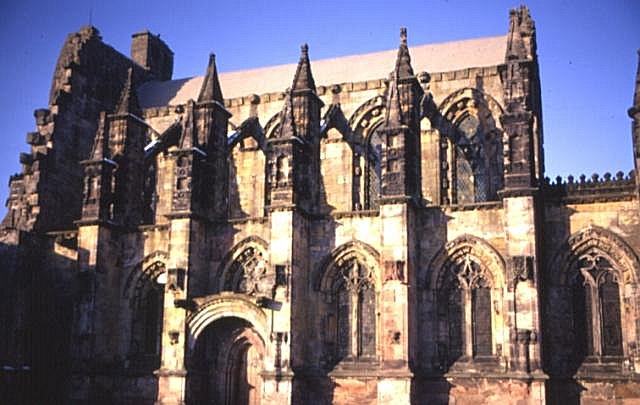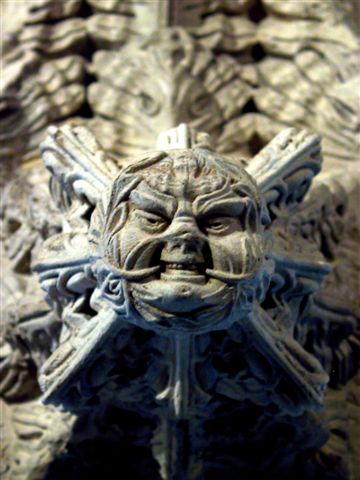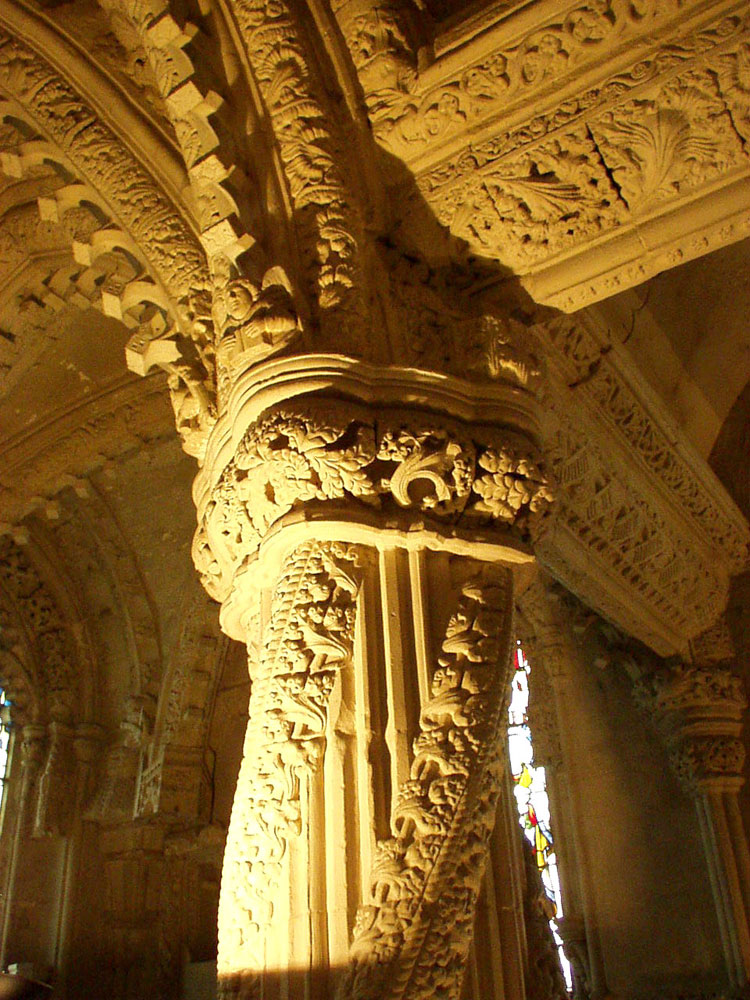In Edinburgh, Scotland there is a building that for years has been shrouded in mystery. Rosslyn Chapel was the last resting place chosen by the Templar Order for their treasure and is said to be the center of peace, as well as a shrine for the scrolls found in Jerusalem during their excavations at the Temple Mount. For years, archaeologists and historians have tried to recover the artifacts that were found on the Holy Land. Ultimately, the discovery of these findings would shed light on thousands of years of knowledge about the St. Clair family and their relationship with the Templar Order. Rosslyn Chapel stands as a memorial to the Knights Templar, hiding a library of secrets about the St. Clair’s of Roslin and sculpted in stone symbolism.
The Templar Order was on a quest for holy artifacts; and William St. Clair of Roslin’s shield carried an engrailed black cross on silver, clearly denoting him as a Grail Knight. This was one of the twists in the mystery of Rosslyn Chapel and the connection with the Templars. Jewish Families had fled Israel to Europe, forming new alliances and holding power and lands in France, therefore instrumenting the formation of the Knights Templar. The Templar Order functioned as protectors of the pilgrims; however in reality they had an entirely different agenda to follow-the recovery of whatever constituted the true treasure of the Temple of Jerusalem (Swanson, 2006).
The Poor Knights of Christ and the Temple of Solomon were founded in Jerusalem in 1118 by Hugh de Payne, Andre de Montbard, and seven other knights. Hugh de Payne was married to Catherine de St. Clair of Roslin and Andre de Montbard, a relative of the Duke of Burgundy, who was also the uncle of Bernard de Fontaines, the most powerful man in Europe in the early twelve century (Baigent, 1982). Initially, the Templars were established to protect the Hold Land; however they became concerned about their role in the church, and why it was believed that they should never bare blood on their shields when their lives had been dedicated to protecting the word of God.
The formation of the Templar Order and their developing appeal was starting to attract free thinkers, one of those being Bernard de Fontaines. Bernard was a leading thinker in the Cistercian Order and he mysteriously became involved with the Knights Templar. For reasons that haven’t been explained, bizarre events started to occur within his noble family. Although his family was shocked at his vocation, they decided to follow him when he joined in 1112. This influx of members more than doubled the size of the Templar Order.
Shortly after Bernard joined, he was suddenly appointed to the position of abbot of the Cistercian Abbey of Clairvaux when he was only twenty four years old. In his position, he transcribed a discourse in which he addressed to Hughes de Payne. The last paragraph reads “Hail, land of promise, which, formerly flowing only with milk and honey for thy possessors, now stretchest forth the food of life, and the means of salvation to the entire world” (Swanson, 2006). The possible translation to this cryptic message could be construed as what was once abundant and plentiful for all, is now only reserved for or controlled by a single entity. Could this have been a reference to the growing power of the Templar Order?
The discovery of certain documentation that the Templars had discovered while excavating under the Temple Mount had alluded to the fact that the crucifixion and the resurrection of Jesus Christ never happened. It was also said that they had found the Ark of the Covenant during their excavations, although many people believe, including me, that the Ark was hidden by the Templars under Rosslyn Chapel. If that was found to be true, it would be one of the greatest discoveries in the world proving once and for all that the Ten Commandments really did exist, challenging Christians to rethink their ideals about the true nature of the resurrection, and whether the body of Jesus Chris was removed from his resting place.
The discoveries of these sacred artifacts and the damaging repercussions they could have had for the Templars could explain why the Templars became multinational conglomerates, richer than any kingdom in Europe. Noble families had donated land showing their commitment to the Order, while Templar buildings were constructed on major trade routes. Their activities directly resulted in the boom of European economics, strengthening the merchant class, which led to the development of capitalism. The Templars created a climate of peace at their trade ports, allowing pilgrims to journey all over Europe, in exchange acting as their personal bankers. Their power grew as a direct result of sacred rituals and an extraordinary mix of military skills.
During the crusades and the suppression of the Templars, the Order had to disappear from site. Some say they fled to Lombardy Scotland, Portugal, and the Baltic states. Many fleeing knights found asylum in lodges of the Craft masons. Knights in Scotland went through an entirely different experience.
The knights who reached Scotland fought with Robert the Bruce and gained royal protection. Sir Henry St. Clair of Roslin and his sons William and Henry took part in the Battle of Bannockburn in 1314, which ultimately rerouted the English and made Robert the Bruce the first true King of Scotland (Albany, 1988). Even today, the legacy of the Bruce lives on in Rosslyn Chapel, which depicts stone angels holding the heart of Robert the Bruce.
Earl William St. Clair, the builder of Rosslyn Chapel, was apparently the Grand Master of the guild of Craft masons in Scotland for unknown reasons. Due to the position of Grand Master being hereditary, it stayed in the St. Clair family until 1736 when Sir William St. Clair of Roslin resigned his hereditary patronage. Therefore, this effected the erection of the Grand Lodge of Freemasons of Scotland (Murphy, 1992).
Earl William St. Clair of Roslin attempted to celebrate the beliefs of the Templar Knights with the erection of Rosslyn Chapel. He created a fireproof library that housed secret coded Templar artifacts and documentation. The chapel is the embodiment of sacred and theosophical acknowledgments, representing a three dimensional structure for late medieval teachings.
Every year thousands of visitors make pilgrimages to Rosslyn Chapel with their guidebook closely at their side, “The Da Vinci Code” by Dan Brown.
Bill Putnam, the Principal Lecturer in Archaeology at Bournemouth University until his retirement, released a magazine article in History Today, along with John Edwin Wood, which peeled away the evidence to find an extraordinary hoax at the heart of Dan Brown’s bestselling novel (Wood, 2009).
Of course, this hasn’t halted the curiosities of many conspiracy theorists and tourist’s who travel to Rosslyn with visions of the Holy Grail, the head of Jesus Christ, and quite possibly the Ark of the Covenant which they believe resides in a chamber below the chapel. Others may visit because they believe it’s a portal for the supernatural. Of course, this isn’t exactly as bizarre as it seems considering Rosslyn is one of seven druidic planetary oracles which was part of an apocalyptic configuration in stone. So what exactly does this mean? The symbolism of the ornate carvings can be interpreted in many different ways, and although many have been deciphered, most of them are a mystery of mixed and conflicting ideologies.
Take for instance the presence of the Green Men which are found all over the chapel. The significance behind the many different carvings of the Green Men is unknown, although William Anderson believes even if one were to regard him as the lowest level, as a mascot of the Masons, his presence in so many regions and over long a period of time indicates that he had a particular meaning to them (Hopkins, 2000). In some legends they speak about a green knight, although the symbolism and the identity of the knight is unknown.
The Apprentice Pillar in Rosslyn Chapel has such an innate quality about it, that is surpasses all the other carvings in the chapel. Hitler had an immense interest in the pillar making the assessment that the Holy Grail was hidden inside. Archaeologists have been able to scan the pillar and have come to the conclusion that a metal object is inside the pillar. Although it would be an amazing opportunity to examine the pillar to its full extent, the curator at Rosslyn will not allow any further investigations or deep scans to verify what’s actually inside. The pillar is said to represent a transformation of the ancient pagan conception, although what most people associate with the pillar is the story of the apprentice who actually built it.
The pillar was intended to be the crowning achievement of the master stonemason; however while the master stonemason was away, his apprentice took the plans and created the pillar himself, far surpassing the skill and beauty defined by the original plans, conceived by the master himself. When the master returned, he beheld the exquisite beauty and surpassing skill with which the pillar had been made, and in a fit of rage he killed the apprentice with a sharp blow to the crown of his head (Green, 2001).
The Egyptians built the pyramids pointing towards the stars in a particular configuration. The nested walls of the Forbidden City were created to surround the world, which the emperor believed revolved around him. Then we have Rosslyn Chapel, a symbol of Templar beliefs constructed in an apocalyptic formation much like Stonehenge or Bluehenge. So what is the meaning behind all of this? A simple explanation would be that the architects knew or could foresee the future. In the case of Rosslyn, Earl St. Clair was believed to hold the key to life’s unanswered questions. Was this because Rosslyn holds all of the artifacts found at the Temple Mount, which ultimately would provide archaeologists and historians thousands of years of knowledge? If the key to life is under the chapel at Rosslyn, we might not ever find the answer.
Resources
Albany, HRH Prince Michael of. The Forgotten Monarchy of Scotland. Shaftesbury: Element Books, 1988.
Baigent, Leigh, Lincoln. The Holy Blood and the Holy Grail. London: Jonathon Cape: Random House, 1982.
Green, Justin E. The Holy Grail: The Legend, the History, the Evidence. Jefferson: McFarland & Company Inc., 2001.
Hopkins, Tim Wallace Murphy & Marilyn. Rosslyn: The Guardian of the Secrets of the Holy Grail. 2nd Edition. Great Britain: Element Books Limited, 2000.
Murphy, Tim Wallace. The Templar Legacy and The Masonic Inheritance Within Rosslyn Chapel. Edinburgh: The Friends of Rosslyn, 1992.
Swanson, Vern G. Dynasty of the Holy Grail: Mormonism's Sacred Bloodline. Springville: Cedar Fort Inc, 2006.
Wood, Bill Putnam and John Edwin. Unravelling the Da Vinci Code. 55 Volume January 2005. 21 October 2009
Recent
Featured Post
ARCHAEOLOGY NEWS: 1/28/2019
ARCHAEOLOGY NEWS – Ancient Digger brings you the latest archaeology news and headlines everyday of the week! Underwater archaeologists ...
Search the Archives
Browse: Home > Monday Ground Up: Rosslyn Chapel, the St. Clair’s of Roslin, and the Templar Order: The Connection







7 Comments:
Wow, lots of great detail. I do not think there is much to find in treasure, that has not already been taken and sold off. It would be cool to find something though!
Rhett out
This is fascinating although I know too little! I've always been of the opinion that the Knights templar were more legend than anything else but it seems that a lot of research has been done and evidence correlated. Very interesting!
This could all be turned into quite an amazing movie.
It has Doug. The DaVinci Code. Although, there was still a lot of information left out of the movie.
I'm ashamed to say my knowledge of the Knights Templar and Rosslyn Chapel didn't extend far beyond the mix of fact and fiction Dan Brown mingled in his novel. It fascinating to read the historical facts.
Well, if I want to understand your blog I'm going to have to get that film.
Excellent and well documented article. I recently wrote on the Knights Templar Castel in Tomar and also on their fabulous chapel in Cressac, and I must say I really enjoyed your work.
Congratulations.
Post a Comment
We appreciate comments, but we delete SPAM.